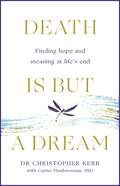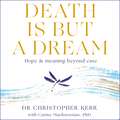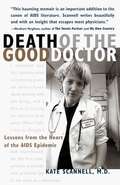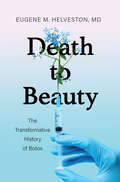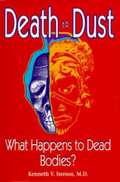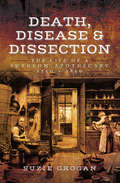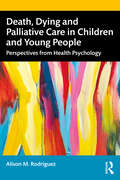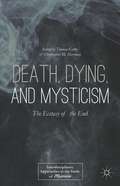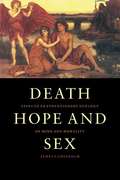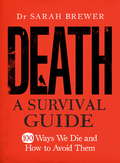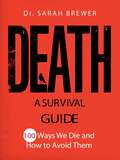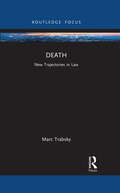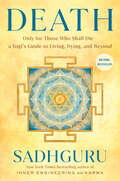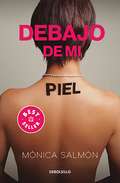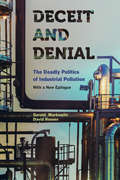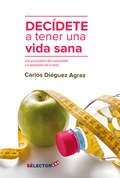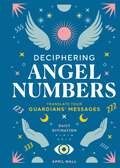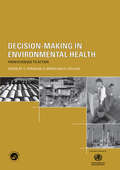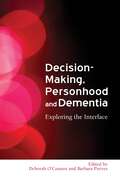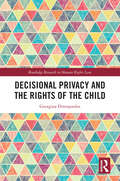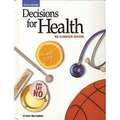- Table View
- List View
Death is But a Dream: Hope and meaning at life's end
by Dr Christopher KerrThe first book to explore the meaningful dreams and visions that bring comfort as death nears. Experiences at the end of life testify to our greatest needs: to love and be loved, to be nurtured and feel connected, to be remembered and forgiven. Christopher Kerr is a hospice doctor. All of his patients die. Yet he has tended to thousands of patients who, in the face of death, speak of love, meaning and grace. They reveal that there is hope beyond cure as they transition to focus on personal meaning. In this extraordinary and beautiful book, Dr. Kerr shares his patients' stories and his own research pointing to death as not purely the end of life, but as a final passage of humanity and transcendence.Drawing on interviews with over 1,200 patients and more than a decade of quantified data , Dr. Kerr reveals why pre-death dreams and visions are remarkable events that bring comfort and exemplify human resilience. These are not regular dreams. Described as "more real than real," they frequently include loved ones long gone and mark the transition from distress to acceptance. These end-of-life experiences help patients restore meaning, make sense of the dying process and assist in reclaiming it as an experience in which they have a say. They also benefit the bereaved who get relief from seeing their loved ones pass with a sense of calm closure.Beautifully written with astonishing stories, this book, at its heart, celebrates the power to reclaim how we die, while soothing the bereaved who witness their loved ones go with unqualified grace.
Death is But a Dream: Hope and meaning at life's end
by Dr Christopher KerrChristopher Kerr is a hospice doctor. All of his patients die. Yet he has tended thousands of patients who, in the face of death, speak of love, meaning and grace. They reveal that there is hope beyond cure as they transition to focus on personal meaning. In this extraordinary and beautiful book, Dr. Kerr shares his patients' stories and his own research pointing to death as not purely the end of life, but as a final passage of humanity and transcendence.Drawing on interviews with over 1,200 patients and more than a decade of quantified data , Dr. Kerr reveals why pre-death dreams and visions are remarkable events that bring comfort and exemplify human resilience. These are not regular dreams. Described as "more real than real," they frequently include loved ones long gone and mark the transition from distress to acceptance. These end-of-life experiences help patients restore meaning, make sense of the dying process and assist in reclaiming it as an experience in which they have a say. They also benefit the bereaved who get relief from seeing their loved ones pass with a sense of calm closure.Beautifully written with astonishing stories, this book, at its heart, celebrates the power to reclaim how we die, while soothing the bereaved who witness their loved ones go with unqualified grace.(P)2020 Random House Audio
Death of the Good Doctor: Lessons from the Heart of the AIDS Epidemic
by Kate ScannellWhen Scannel found herself assigned to a county hospital AIDS ward, she realized that much of the medicine she had studied was irrelevant. She chronicles the intimacy of her relationships with her patients, and discovers the inadequacy of the "good" doctor who battles illness to keep patients alive regardless of their suffering. She writes not only as a physician but as a woman who entered medical school never having seen a woman doctor.
Death to Beauty: The Transformative History of Botox
by Eugene M. HelvestonIn the 1970s, Dr. Alan Scott sought to selectively weaken eye muscles to treat strabismus (when one or both eyes are misaligned) without surgery. After failed attempts with other agents, Scott developed a method to stabilize the bacteria that causes botulism, culminating in a drug that eventually became known as Botox. In Death to Beauty, Eugene M. Helveston, MD, follows the unlikely story of botulism's 1817 discovery in contaminated German sausages, to its use in military and research facilities, to Scott, an ophthalmologist who aimed to safely use the drug in humans. Scott struggled alone as an unknown in the pharmaceutical industry, searching for clinical trial financing and FDA approval, which he achieved at a fraction of the billions big pharma usually spends to bring a drug to market. Eventually, the company Allergan bought him out, capitalizing on the possibilities for cosmetic uses. Scott's formula was renamed "Botox" and reached annual sales in the billions. After the sale, Scott received no further compensation from Botox sales and remained the same unassuming man.A fascinating walk through the intricate history of how the world's deadliest toxin starting as a treatment for crossed eyes became a routine tool for the cosmetic industry, Death to Beauty will make you rethink success, beauty, and deadly bacteria.
Death to Dust: What Happens to Dead Bodies
by Kenneth V. IsersonA tome about every conceivable aspect of being dead, as a guide for medical professionals and an aid for people in general to decide what to have done with their bodies. Iserson himself hopes to convince people to donate them to research, but he is not pushy about it. He explores how death is determined, autopsies are done, people are cryonically preserved, heads are shrunk, corpses are transported; and why people rob graves, use coffins, cremate bodies, bury people prematurely, and use corpses in research and training. No gruesome photographs. Totally documented content with multiple footnotes, references, glossary, appendices. Available from Galen Press Ltd., PO Box 64400, Tucson, AZ 85728-4400. Annotation copyright by Book News, Inc., Portland, OR
Death, Disease & Dissection: The Life of a Surgeon–Apothecary 1750–1850
by Suzie GroganImagine performing surgery on a patient without anesthetic, administering medicine that could kill or cure. Welcome to the world of the surgeon-apothecary... During the eighteenth and nineteenth centuries significant changes occurred in medicine. New treatments were developed and medical training improved. Yet, with doctors' fees out of the reach of ordinary people, most relied on the advice of their local apothecary, among them, the poet John Keats, who worked at Guys Hospital in London. These men were the general practitioners of their time, making up pills and potions for everything from toothache to childbirth. Death, Disease and Dissection examines the vital role these men played their training, the role they played within their communities, the treatments they offered, both quack and reputable against the shocking sights and sounds in hospitals and operating theaters of the time. Suzie Grogan transports readers through 100 years of medical history, exploring the impact of illness and death and bringing the experiences of the surgeon apothecary vividly to life.
Death, Dying and Palliative Care in Children and Young People: Perspectives from Health Psychology
by Alison M. RodriguezDeath, Dying and Palliative Care in Children and Young People: Perspectives from Health Psychology examines the issues relevant to children and young people living with serious illness and their families by taking a closer look at the literature and knowledge around the processes of care, health, well-being and development through a health psychology lens. The text introduces readers to the general palliative and holistic care needs of children and young people along with the nuances of caring relationships. The chapters discuss the vulnerabilities encountered in living with serious illness and facing a shortened life prognosis, being at the end of life, and issues relative to the historical concept of the ‘good death’ or ‘dying well’, grief, and bereavement. The author examines how individual and familial experiences can be multi-layered, which can consequently influence perceptions and behaviours. The text therefore offers a deep exploration of the varied ways in which people draw on different resources to navigate their palliative care lived experiences. The book will be beneficial to the students of, and individuals interested in, psychology and nursing along with other health and social care courses. It will further be of interest to individuals interested in gaining more understanding of the experiential aspects of death, dying and palliative care in children and young people from health psychology perspectives.
Death, Dying, and Mysticism
by Thomas Cattoi Christopher M. MoremanThis volume offers a sample of reflections from scholars and practitioners on the theme of death and dying from scholars and practitioners, ranging from the Christian tradition to Hinduism, Lacanian psychoanalysis, while also touching on the themes of the afterlife and near-death experiences.
Death, Hope And Sex: Steps To An Evolutionary Ecology Of Mind And Morality
by James S. ChisholmBy showing how and why human nature is what it is, evolutionary theory can help us see better what we need to do to improve the human condition. Following evolutionary theory to its logical conclusion, Death, Hope and Sex uses life history theory and attachment theory to construct a model of human nature in which critical features are understood in terms of the development of alternative reproductive strategies contingent on environmental risk and uncertainty. James Chisholm examines the implications of this model for perspectives on concerns associated with human reproduction, including teen pregnancy, and young male violence. He thus develops new approaches for thorny issues such as the nature-nurture and mind-body dichotomies. Bridging the gap between the social and biological sciences, this far-reaching volume will be a source of inspiration, debate and discussion for all those interested in the evolution of human nature and the potential for an evolutionary humanism.
Death: A Survival Guide
by Dr Sarah BrewerWe all have a 100 per cent chance of dying - eventually. But when are you most at risk? Which are the world's biggest killers? And what can you do to postpone the inevitable? Death - A Survival Guide offers a unique insight into the biggest threats to life and limb in the industrialized world. Sarah Brewer's comprehensive and thorough survey of the most likely ways to die in the industrialized world looks at 100 causes of death from the most common such as heart disease, smoking related deaths and domestic accidents to the unusual and downright bizarre lightning strikes and animal attacks. This fascinating - and occasionally sideways - look at death and dying will help you understand the most common causes of death and how each one affects the human body. View at a glance statistics reveal who dies where, when and how often; lists of warning signs, symptoms and risk factors allow you to determine the chances of it happening to you; and finally case studies on prevention, treatment and cures describe the best steps you can take to avoid meeting your maker in this way. Aeroplane crash; Anaphylactic shock; Aortic aneurysm; Brain tumour; Breast cancer; Creutzfeldt-Jacob disease; Dehydration; Dementia; Domestic accidents; Heart attack; Influenza; Malaria; Occupational hazards at work; Over-exertion; Pulmonary Embolism; Respiratory failure.
Death: A Survival Guide
by Sarah BrewerWe all have a 100% chance of dying--eventually. But what are the world's biggest killers? When are you most at risk? And what can you do to postpone the inevitable for as long as possible? Death: A Survival Guide offers a unique insight into the biggest threats to life and limb in the industrialized world. Sarah Brewer's comprehensive and thorough survey looks at 100 causes of death from the most common such as heart disease, smoking related deaths and domestic accidents to the unusual and downright bizarre lightning strikes and animal attacks. This fascinating--and occasionally sideways--look at death and dying will help you understand the most common causes of death and how each one affects the human body. "At a glance" statistics reveal who dies where, when and how often; lists of warning signs, symptoms and risk factors allow you to determine the chances of it happening to you; and finally case studies on prevention, treatment and cures describe the best steps you can take to avoid meeting your maker in this way.
Death: A Survival Guide
by Sarah BrewerWe all have a 100 per cent chance of dying - eventually. But when are you most at risk? Which are the world's biggest killers? And what can you do to postpone the inevitable? Death - A Survival Guide offers a unique insight into the biggest threats to life and limb in the industrialized world. Sarah Brewer's comprehensive and thorough survey of the most likely ways to die in the industrialized world looks at 100 causes of death from the most common such as heart disease, smoking related deaths and domestic accidents to the unusual and downright bizarre lightning strikes and animal attacks. This fascinating - and occasionally sideways - look at death and dying will help you understand the most common causes of death and how each one affects the human body. View at a glance statistics reveal who dies where, when and how often; lists of warning signs, symptoms and risk factors allow you to determine the chances of it happening to you; and finally case studies on prevention, treatment and cures describe the best steps you can take to avoid meeting your maker in this way. Aeroplane crash; Anaphylactic shock; Aortic aneurysm; Brain tumour; Breast cancer; Creutzfeldt-Jacob disease; Dehydration; Dementia; Domestic accidents; Heart attack; Influenza; Malaria; Occupational hazards at work; Over-exertion; Pulmonary Embolism; Respiratory failure.
Death: New Trajectories in Law (New Trajectories in Law)
by Marc TrabskyThis book examines how legal institutions reify the value of death in the twenty-first century. Its starting point is that bio-technological innovations have extended life to such an extent that death has become an epistemological problem for legal institutions. It explores how legal definitions of death are subject to the governing logic of economisation, how legal technologies for registering a death reshape what kind of deaths are counted during a pandemic, and how technologies for recycling cadaveric tissue problematise the legal status of the corpse. The question that unites each chapter is how legal institutions respond to technologies that bring death before their laws. The book argues for an interdisciplinary approach, informed by the writings of Georges Bataille, Wendy Brown, Georges Canguilhem and Michel Foucault, to understand how legal epistemologies are increasingly disrupted, challenged, and countered by technologies that repurpose death to extend, nourish and foster human life. It contends that legal theorists and social scientists need to rethink doctrinal perspectives of law when theorising how law defines the moment of death, shapes what kind of deaths count, and recycles the debris of the dead. This book will appeal to a broad international readership with research interests in critical theory, political theory, legal theory or death studies; and it will be particularly useful for teachers and students who are searching for an accessible entry point to the study of the intersections between law and death.
Death: Only for Those Who Shall Die--a Yogi's Guide to Living, Dying, and Beyond
by SadhguruYogi, mystic, and bestselling author Sadhguru provides a deeper understanding of death so that we can live more fulfilling lives.Death is an inevitable part of our lives, yet most societies have struggled to come to terms with it. Today, we continue to grapple with the enduring questions: What is death? Why do we fear it? What happens after death? Is it an end or a doorway to something beyond?In this unique, clear-sighted exploration of death, Sadhguru dwells extensively upon his inner experience as he expounds on the deeper aspects of death that are rarely spoken about. What if death is not the catastrophe it is made out to be, but an essential aspect of life, rife with spiritual possibilities for transcendence? Avoiding death is avoiding life. Our fear of death is really a fear of loss. Sadhguru shows us how to go beyond that fear so that it no longer rules our behavior. He invites you to explore how living with an awareness of mortality can allow you to experience life more deeply. Coming to terms with death will ensure that you live purposefully, striving to make each moment as beautiful as it can be.Sadhguru also breaks down the mysteries surrounding death, including practical aspects such as what preparations one can make for one&’s death, how best we can assist someone who is dying, and how we can continue to support their journey even after death. Drawing from profound wisdom and his own transformative journey, Sadhguru delivers an entirely new and necessary perspective—death not as an end, but part of the continuum of existence.
Death: The Final Mystery
by Lionel And FanthorpeThe greatest human problem is that we are all born in the condemned cell. Money and medical science can extend the human lifespan significantly — perhaps up to one thousand years via cloning and cryogenics — but in the end, when the last medical miracle has been exhausted, Death still waits patiently for us. In Death: The Final Mystery, Lionel and Patricia Fanthorpe take their investigative skills to those last moments of life and beyond, exploring such puzzling topics as near-death and out-of-body experiences, reincarnation theories, hypno-regression, and automatic writing and other phenomena of the séance room. Evidence is drawn from trance mediums, the writings of mystics, and clear, hard facts reported by reliable eyewitnesses.
Debajo de mi piel
by Mónica Salmón«Mónica Salmón acompaña a su madre en la batalla contra el cáncer y, al compartirla en palabras, dignifica la pérdida y nos muestra la grandeza del amor filial.» MÓNICA LAVÍN «Un entrañable y solidario testimonio que nos enseña página a página que el cáncer es más un sinónimo de vida que de muerte. Mónica Salmón logra levantar el velo de la enfermedad más temida para mostrarnos el inagotable amor y valentía que realmente inspira.» BLAS VALDEZ «Debajo de mi piel es una experiencia que nos expone a la fragilidad de la vida, pero también nos recuerda la increíble fuerza del amor que yace en todos nosotros para dejarnos la importante lección de vivir y de nunca dejar de amar.» ERIC MANCEBO
Deceit and Denial
by David Rosner Gerald MarkowitzDeceit and Denial details the attempts by the chemical and lead industries to deceive Americans about the dangers that their deadly products present to workers, the public, and consumers. Gerald Markowitz and David Rosner pursued evidence steadily and relentlessly, interviewed the important players, investigated untapped sources, and uncovered a bruising story of cynical and cruel disregard for health and human rights. This resulting exposé is full of startling revelations, provocative arguments, and disturbing conclusions--all based on remarkable research and information gleaned from secret industry documents. This book reveals for the first time the public relations campaign that the lead industry undertook to convince Americans to use its deadly product to paint walls, toys, furniture, and other objects in America's homes, despite a wealth of information that children were at risk for serious brain damage and death from ingesting this poison. This book highlights the immediate dangers ordinary citizens face because of the relentless failure of industrial polluters to warn, inform, and protect their workers and neighbors. It offers a historical analysis of how corporate control over scientific research has undermined the process of proving the links between toxic chemicals and disease. The authors also describe the wisdom, courage, and determination of workers and community members who continue to voice their concerns in spite of vicious opposition. Readable, ground-breaking, and revelatory, Deceit and Denial provides crucial answers to questions of dangerous environmental degradation, escalating corporate greed, and governmental disregard for its citizens' safety and health. After eleven years, Markowitz and Rosner update their work with a new epilogue that outlines the attempts these industries have made to undermine and create doubt about the accuracy of the information in this book.
Decidete a tener una vida sana
by Carlos Diéguez AgrazLa elección de llevar una vida sana se trata de impulsar al lector a tomar una postura más consciente, proactiva y responsable sobre su salud y bienestar. A lo largo del libro se abordan temas de gran interés para la vida presente y futura de cada persona y que, no obstante su importancia y trascendencia, no se enseñan en los espacios académicos comunes. El tradicional enfoque de la salud requiere ser transformado hacia prácticas preventivas y de autocuidado, con costos significativamente menores para todos: el estado, las empresas y las personas; pero además con los grandes beneficios que goza quien tiene una vida mucho más plena y saludable, quienes lo rodean y la sociedad en su conjunto. Tomar las riendas y el control de la propia vida es una decisión personal. Contribuir y guiar al lector para alcanzar este gran objetivo es el deseo sincero del autor.
Deciphering Angel Numbers: Translate Your Guardians' Messages
by April WallDiscover the mystical meaning of angel numbers and the connection they have to your higher self. Follow along and find all of your answers in Deciphering Angel Numbers.As the third book in Weldon Owen&’s Daily Divination series, Deciphering Angel Numbers dives into numerology to define the concept of angel numbers and explores the unique history of the mystical practice. Angel numbers are a large part of modern metaphysical practices, and these trios of numbers are a wonderful tool in managing life challenges, recognizing messages from spirit guides, and staying connected to those who have passed on. Join author April Wall as she provides a complete history of angel numbers, including a full glossary on all the numbers, who sends them, explanations on how to interpret them accurately, and all the answers you need in learning how to incorporate their spiritual meanings into your daily life. ALL OF YOUR ANGEL NUMBER QUESTIONS ANSWERED: The only angel number guidebook you will ever need! With thorough explanations, tips on finding the patterns, and a history of numerology, this guide is the total package. COMPLETE YOUR COLLECTION: Collect the entire Daily Divination series to increase your divination skill set. EXPERT GUIDANCE: Author April Wall has worked in the metaphysical space for over ten years. She is an authentic and reliable source in learning to communicate with your higher self and those beyond. PERFECT GIFT: This book makes the perfect gift for any mind, body, and spirit enthusiast in your life.
Decision Making in Health and Medicine
by Joseph S. Pliskin M.G. Myriam Hunink Milton C. Weinstein Eve Wittenberg Michael F. Drummond Joseph S. Pliskin John B. Wong Paul P. Glasziou M.G. Myriam Hunink Milton C. Weinstein Eve Wittenberg Michael F. Drummond John B. WongDecision making in health care means navigating through a complex and tangled web of diagnostic and therapeutic uncertainties, patient preferences and values, and costs. In addition, medical therapies may include side effects, surgery may lead to undesirable complications, and diagnostic technologies may produce inconclusive results. In many clinical and health policy decisions it is necessary to counterbalance benefits and risks, and to trade off competing objectives such as maximizing life expectancy vs optimizing quality of life vs minimizing the required resources. This textbook plots a clear course through these complex and conflicting variables. It clearly explains and illustrates tools for integrating quantitative evidence-based data and subjective outcome values in making clinical and health policy decisions. An accompanying CD-ROM features solutions to the exercises, PowerPoint® presentations of the illustrations, and sample models and tables.
Decision-Making in Environmental Health: From Evidence to Action
by D. Briggs C. Corvalan G. ZielhuisDecision-Making in Environmental Health examines the need for information in support of decision-making in environmental health. It discusses indicators of environmental health, methods of data collection and the assessment of exposure to and the health impact of different environmental risk factors.
Decision-Making, Personhood and Dementia: Exploring the Interface
by Barbara Purves Deborah O'ConnorDementia is a devastating disorder which may dramatically interfere with decision-making abilities. Effort has focused on trying to determine when a person is no longer capable of making particular decisions or is globally incompetent. However, much less focus has been placed on understanding how the capacity to make decisions influences one's view of oneself, one's world and one's treatment by others. This book aims to broaden discussion around this issue by moving beyond a focus on notions of capability and competence to explore the importance of personhood and the underlying complexities of decision-making for those with dementia. Based on papers from the Centre for Research on Personhood in Dementia (CRPD) workshop, experts in dementia care, law, ethics and philosophy discuss the interface between dementia, personhood and decision-making. Drawing on a wide range of interdisciplinary and international perspectives, the book forges new understandings of relationships between everyday, informal decision-making and more formal biomedical or legal processes for assessing competence. This collection of papers provides an in-depth understanding of decision-making in relation to dementia for researchers, healthcare practitioners, service providers, legal professionals and anyone with an interest in personhood in dementia care.
Decisional Privacy and the Rights of the Child (Routledge Research in Human Rights Law)
by Georgina DimopoulosDecisional privacy gives individuals the freedom to act and make decisions about how they live their lives, without unjustifiable interference from other individuals or the state. This book advances a theory of a child’s right to decisional privacy. It draws on the framework of the United Nations Convention on the Rights of the Child and extends the work of respected children’s rights scholars to address a significant gap in understanding the interconnections between privacy, family law and children’s rights. It contextualises the theory through a case study: judicial proceedings concerning medical treatment for children experiencing gender dysphoria. This work argues that recognising a substantive right to decisional privacy for children requires procedural rights that facilitate children’s meaningful participation in decision-making about their best interests. It also argues that, as courts have increasingly encroached upon decision-making regarding children’s medical treatment, they have denied the decisional privacy rights of transgender and gender diverse children. This book will benefit researchers, students, judicial officers and practitioners in various jurisdictions worldwide grappling with the tensions between children’s rights, parental responsibilities and state duties in relation to children’s best interests, and with the challenge of better enabling and listening to children’s voices in decision-making processes.
Decisions For Health
by Vivian BernsteinDecisions for Health : The Complete Edition by Vivian Bernstein
Decisions For Health (Level Green, Texas Edition)
by Holt Rinehart WinstonWhen you think of health, you probably think about your physical health. Your physical health is the part of your health that deals with the condition of your body. Things that you can do to maintain your physical health include the following: eating balanced meals, engaging in physical activity, getting 8 hours of sleep every night, maintaining good hygiene
